Animal Survival
Animal
Defenses
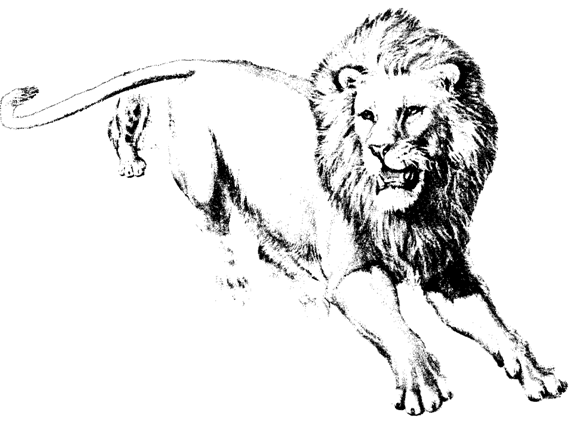
Only the largest and strongest animals can live without fear
of being caught and killed by meat-eating carnivorous animals. However, nearly
every animal has some way of defending itself against enemies. Some animals are
swift and can outrun their enemies. Other, slower animals cannot escape by
running away, but they defend themselves by hiding in a safe place. To reduce
the chances of being seen by their enemies, some animals spend all their lives
in holes or crevices, while others are colored in such a way that they go
unnoticed against their background.
If an animal cannot escape its enemies, it has to protect
itself in other ways. Many do so by biting, kicking, using horns or antlers, or
using special defenses such as stingers.
A few animals pretend to be dead or injured when being
attacked, and the enemy gives up and looks for a better meal elsewhere. To
protect their heads and bodies, certain lizards cast off their tails for the
enemy to eat, and grow a new tail.
Animal
Smell
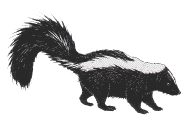
When a skunk is attacked, it squirts its attacker with a jet
of foul smelling fluid from special glands at the base of its tail. When the
fluid hits the attacker, that attacker will start to choke and may be blinded
for a short time. Skunks have white stripes on their bodies that warn animals
not to attack them.
The grass snake also protects itself by giving off an
unpleasant smell if disturbed.
Stingers
Some animals sting with a sharp, hollow tube that injects
poison into its enemy. The tube is somewhat like a needle that a doctor uses
for injections.
Sea anemones and cone shells sting the animals that they eat,
but they also sting other enemies. Bees use their ability to sting for
defensive purposes. Any animal that tries to break open a hive to get honey is
attacked by a swarm of bees.
Insects such as scorpions have stingers at the end of their
tails. A bulb of deadly poison is next to the scorpion’s stinger. The scorpion
grabs its enemy with its claws, flips its tail over its head, and stabs the
enemy with its stinger. The poison flows down the stinger into the body of the
enemy. The stinger of a scorpion works something like the fangs of a poisonous
snake.
Spiny
Coats
The European hedgehog’s back is covered with a dense coat of
sharp prickles. When alarmed, it raises the prickles, and then it rolls into a ball.
It tucks its head and legs under its belly so that its enemy can find nothing
but the sharp prickles.
Porcupines have coat spines, which are much longer than the
hedgehog’s prickles. The spines of the African porcupine come out easily and
stick deep into the flesh of any animal that comes into contact with them.
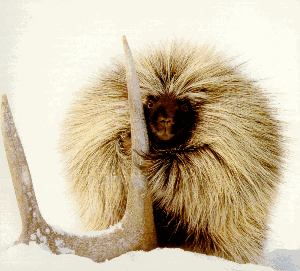
Porcupine
Claws
The lobster uses its two large claws to catch crabs and fish
for food. One claw is heavy and has thick teeth, and the other claw is smaller
and has sharp teeth. The smaller claw is used to tear prey apart so that it’s
easy to eat.
Horns
Bulls and buffalos use their horns as weapons. The horns are
sharp, and point forward like short swords. When horned animals attack, they
lower their heads, run toward their enemy, and ram their horns into the enemy,
wounding it.
Fangs and Strong Body
Camouflage
Camouflage is a way of disguising the appearance of something
so that it cannot be seen. Many animals have colors that match their
surroundings, making them difficult to see. Some moths match the lichen-covered
bark of trees so they can escape from birds. The chameleon and the octopus can
change color to blend in with their surroundings. Another kind of camouflage
used by animals takes advantage of their shape making them difficult to see.
The stick insect, which looks like a twig, is an example of this type of
camouflage.
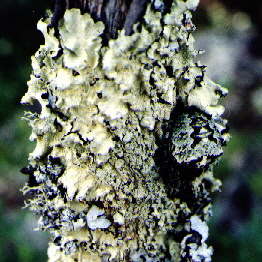
There is a spider hiding on this
lichen. Can you see it?
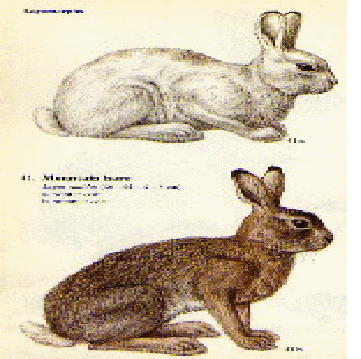
In the winter the rabbit fur is white, to blend in
with the snow. In the summer it turns brown to match the darker colors of the
forest.
Colors
Many insects are boldly marked with red and black or yellow
and black patterns. Some of these creatures have an unpleasant taste, and they
may be poisonous. The bright colors warn their enemies of this. Animals learn
to leave yellow-striped wasps and bees alone because of their stings. The
Burnet Moth of Europe has bright, metallic colors. Its body contains the poison
cyanide, and birds learn not to eat this brightly colored moth. American
Monarch butterflies are also brightly colored, and their bodies contain a heart
poison.
Not all brightly colored insects are unpleasant. There are
many imposters, that have bold patterns, but are harmless.
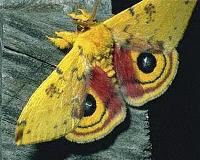
When this Io moth is threatened it pulls back its upper wing revealing
these "Eyes" which startle the attacker long enough for the moth to
escape.
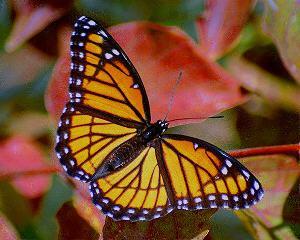
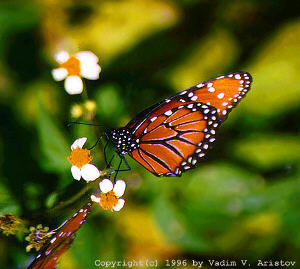
|
The Viceroy
Butterfly tastes great (to birds) but the birds who have learned that
butterflies with black and orange wings (Monarchs) taste bad won't eat the
Viceroys. The Viceroy is the mimic, and the Monarch is the Model |
Bluff
One way that a helpless animal can defend itself is to
pretend that it is large and fierce. The Frilled Lizard of Australia gets its
name from the frill of skin around its neck. The lizard is forty inches long,
but it is harmless. When attacked, it spreads its frill. The frill looks like
an open umbrella, makes the lizard look enormous, and the frightened enemy runs
away.
The Peacock Butterfly sits on a twig with its wings closed.
When frightened, it opens its wings and shows its large, colored spots which
look like eyes. The way they suddenly appear startles enemies. Several other
kinds of butterflies and moths also have “eyes” on their wings.
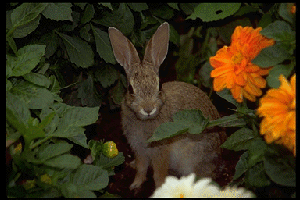
Eyes set
out on the sides of the head, and big ears help this rabbit detect predators.
Body structures also are weapons that animals can use for protection,
defense, and obtaining food. Look at the following examples.
Rhinoceros – Its horn is used for fighting and digging up juicy plants.
Animals keep out of its way because it looks so fierce.
Giraffe – Patchwork markings help hide a giraffe among trees. A giraffe’s neck
stretches to eat leaves high in tees. Its thick eyelashes protect a giraffe’s
eyes from wind and dust. It defends itself with hooves.
Hippopotamus – A hippo flashes long, sharp teeth when it is angry. A
hippo keeps its eyes just above the water to spot enemies.
Zebra – A zebra listens for danger while others nibble at the grass. A bony
hoof covers each foot and protects it like a shoe. Big, flat teeth are good for
chewing tough clumps of grass.
Lion – A lion’s golden fur hides it in dry yellow grass. A shaggy mane makes
a father lion look big and frightening. Sharp front teeth and powerful jaws
help a lion catch and grip its food. A lion creeps up to its enemies on its
soft, padded paws.
Elephant – An elephant uses its nose, called a trunk, for drinking water,
carrying food, and making a loud noise just like a trumpet. The bendable trunk
is useful for pulling tasty twigs off trees. It sniffs its food through two
nostrils to find out if it is good to eat. It digs up juicy plants with long,
curved tusks.
Cheetah – Its tail keeps it steady when it turns while running fast in pursuit
of food. A yellow coat with black spots hides the cheetah as it moves through
the grass. Powerful, long, legs and strong claws, digging into the hard ground,
help a cheetah run fast.
Fox
– A fox has good hearing and good eyesight for hunting.
Wolf – A wolf has a thick coat for warmth. Its tail is used for steering and to
keep warm. A wolf can run long distances at up to 43 miles per hour. He has a
good sense of smell for hunting, and his strong bite seizes and holds his prey.
Brown Bear – A brown bear is a good swimmer, and can stand on its hind
legs to view an area, and can run faster than people. His teeth are designed to
eat plants and meat. A brown bear uses claws for weapons and climbing, and to
dig for mice and roots.
Camel – A camel’s long eyelashes protect it from blowing sand, and its
nostrils can be closed for protection from that same blowing sand. It does not
need much water to survive. It has wide feet to keep it from sinking into sand.
When fighting, it bites other animals in the neck, legs, or throat.
Walrus – A walrus uses its head to break holes in ice, and its whiskers feel
the sea floor for food. It uses it snout for digging out clams. Its tusks are
used for climbing, breaking oysters off rocks, and frightening or attacking
enemies.
Birds of Prey – Have good eyesight, strong hooked beaks for attacking and
tearing food, sharp claws for hunting, and are swift flyers.
Activity I
Make a collage using wildlife pictures you find in magazines.
Activity II
Write to the United States Department of Interior,
Publications Unit, Fish and Wildlife Service,
Activity III
Contact a nature organization in your area. Ask how you can
become involved in helping save wildlife.
Activity IV
Create a play featuring wildlife puppets with your friends. Decorate
a large box with each of the four seasons painted on the four sides. Use the
box to present your puppet play to others.
Activity V
Visit the zoo. Make a list of all the animals you see. Which
ones are endangered?
Activity VI
Visit a national wildlife refuge. Volunteer to help on
special projects.
Activity VII
Organize a fundraiser at your school or in your neighborhood
to raise money to help save endangered animals.
Activity VIII
Read books from the library about wildlife. Subscribe to wildlife
magazines, such as Ranger Rick or Your Backyard.
Activity IX
Do not buy wild or exotic animals as pets. Also, do not buy
fur, bearskin rugs, ivory, or any other products that endanger animals.
Activity X
Educate your friends about respecting wildlife. Ask them not
to participate in acts of carelessness or cruelty that could injure an animal.
Suggested Books to Read:
You may visit your local library to read about animals or
your choice or read some of the following books.
Animals Around Us by Lazier (Creative Education)
Animals do the Strangest Things by Leonora and Arthur Hornblow
(Random House)
Animals Hide and Seek by Barbara Taylor (DK Publishing)
Colors by Rebecca Grambo (Kidsbooks, Inc.)
Deadly Creatures by Camilla De La Bedoyere (Flame
Tree Publishing)
Defenses by Rebecca Grambo (Kidsbooks, Inc.)
What Color is Camouflage by Carolyn Otto (Harper Collins)
Wild Animals by Monika Baierlacher (Gareth
Stevens)
Wild Animals by Sarah Fecher (World Book, Inc.)
